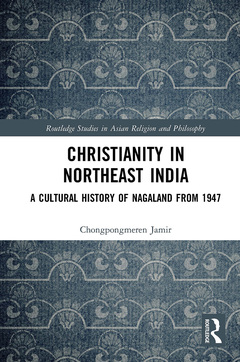Christianity in Northeast India A Cultural History of Nagaland from 1947 Routledge Studies in Asian Religion and Philosophy Series
Auteur : Jamir Chongpongmeren

This book examines the distinctive formation of Christianity in Nagaland, Northeast India, since 1947. It argues that an understanding of the history of Christianity in the region can be found in its cultural milieu and the changing political, social and religious environment.
In Nagaland, almost 90 per cent of the population are Christians. This book shows that segmentation as a cultural characteristic of Naga society inspired both unity and divisiveness in the Naga churches, which subsequently shaped the beliefs and practices of the churches in the region. Using the methodology of cultural history, the author examines ecclesiastical events and suggests that the history of Christianity should be examined in the light of its interaction with its cultural context rather than as an isolated phenomenon. The book demonstrates that the ethnic status which the Christian faith assumed, the extent of its identification with the local culture, and the scope of the mission of the Naga churches as key stakeholders in society, offers a new angle on the history of Christianity in India.
This book will be of interest to scholars and researchers of South Asian history, particularly those concerned with Northeast India and Christian history, historiography, cultural history, history of Christianity in India and faith?culture interface, religious studies, history and South Asian Studies.
Introduction
1. The Nagas: A segmentary society
2. Amidst the whirlwind of transition, 1947-63
3. In the midst of a society in crisis, 1964-89
4. Within a deeply divided society, 1990 onwards
Conclusion: Segmentation, unity and a church divided
Chongpongmeren Jamir is Associate Professor at the South Asia Institute of Advance Christian Studies (SAIACS), India.
Date de parution : 08-2022
15.6x23.4 cm
Date de parution : 05-2020
15.6x23.4 cm
Thème de Christianity in Northeast India :
Mots-clés :
Young Men; Naga Society; Nagaland; Christianity; Northeast India; cultural history; Christian history; historiography; cultural history; history of Christianity in India; Naga Churches; religious environment; Naga People; South Asian studies; Naga Nationalists; Northeast India; Tamil Nadu; Christianity; Konyak Naga; cultural history; Naga Context; Naga Tribes; Naga Christian; Naga Hills; Ao Naga; Angami Naga; American Baptist Missionary; NNC; Naga Villages; Missionary Introduction; Naga Club; NCRC; Cultural History Methodology; Bachelor House; Indian People; Nation Building; Segmentary Society; Civil Societies



